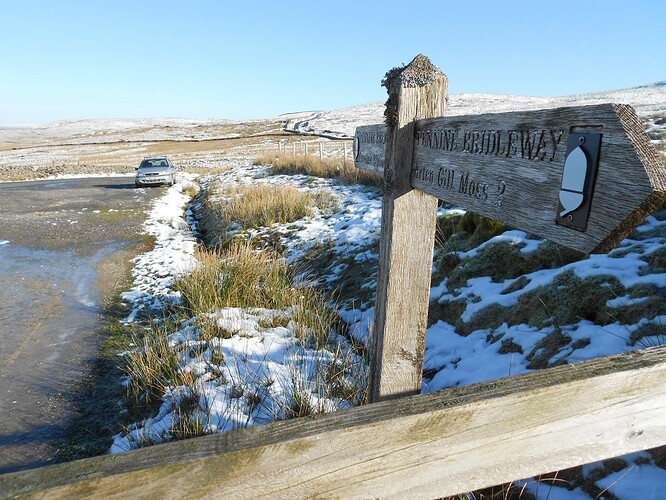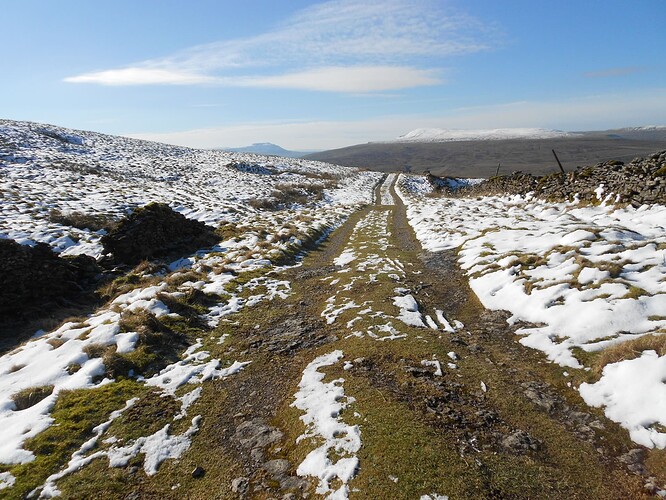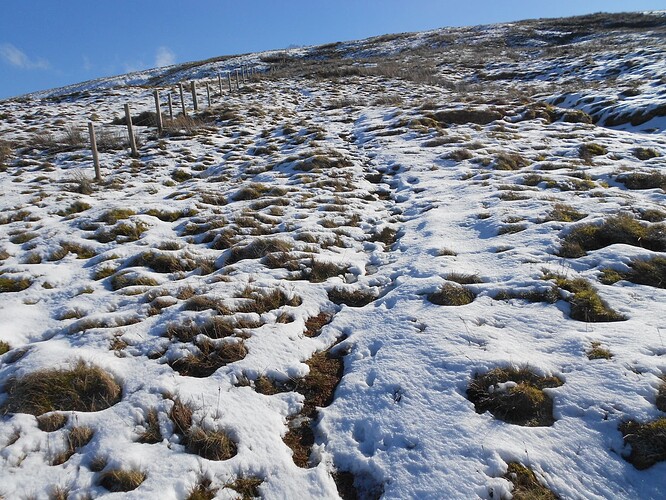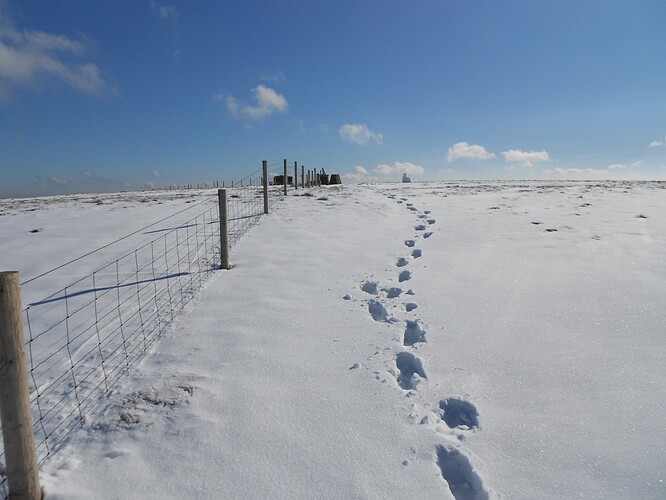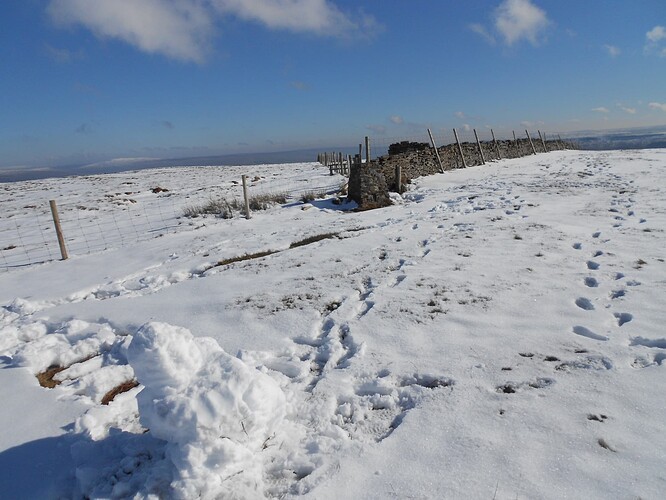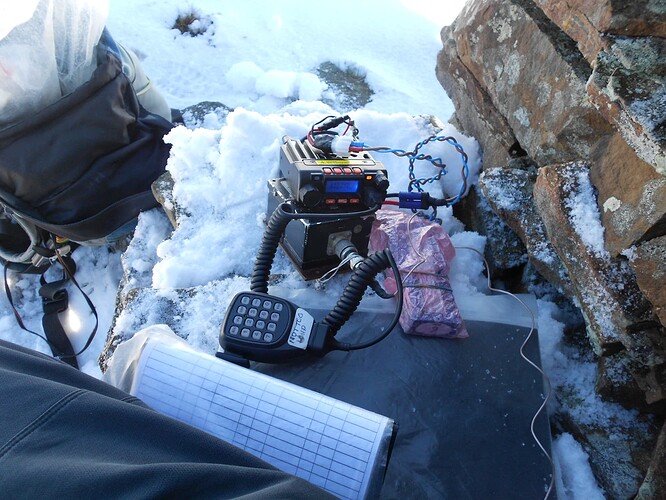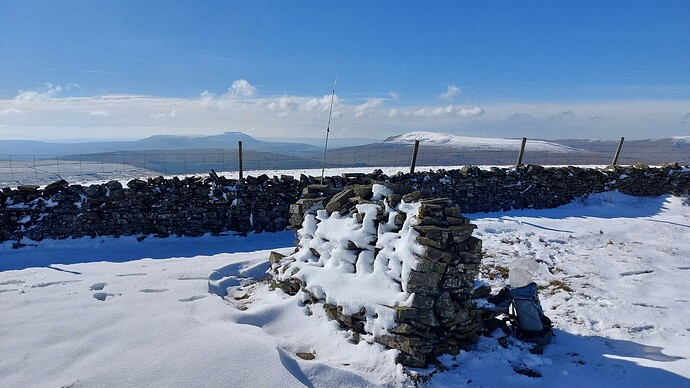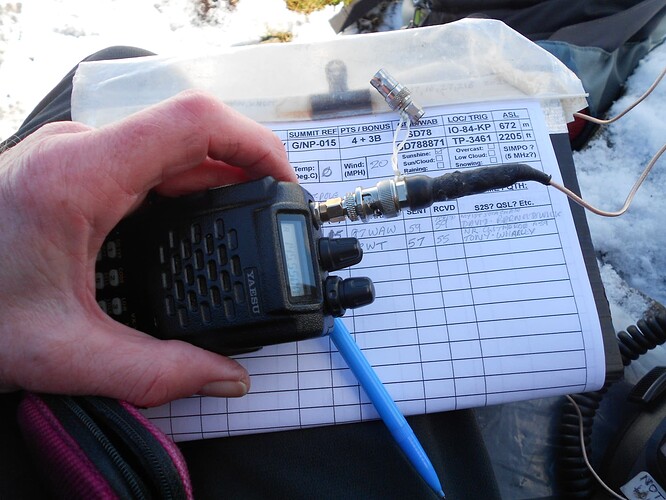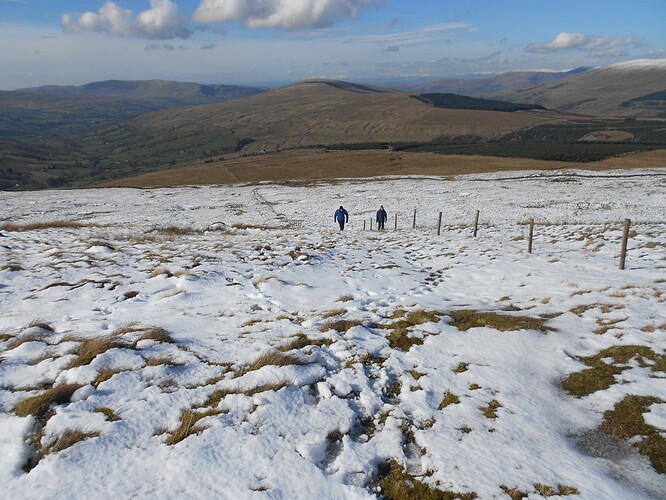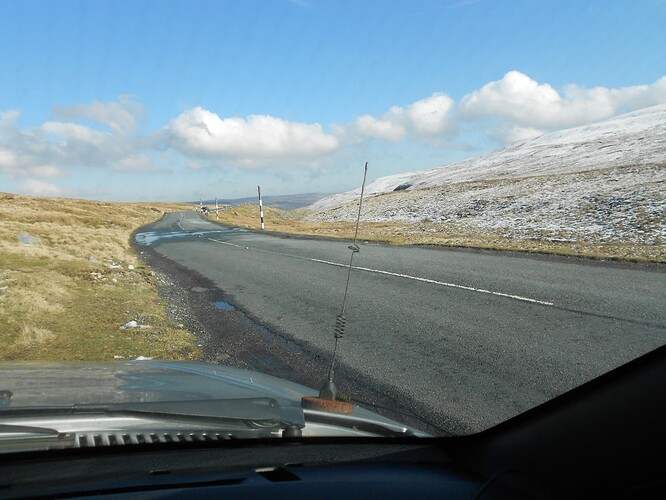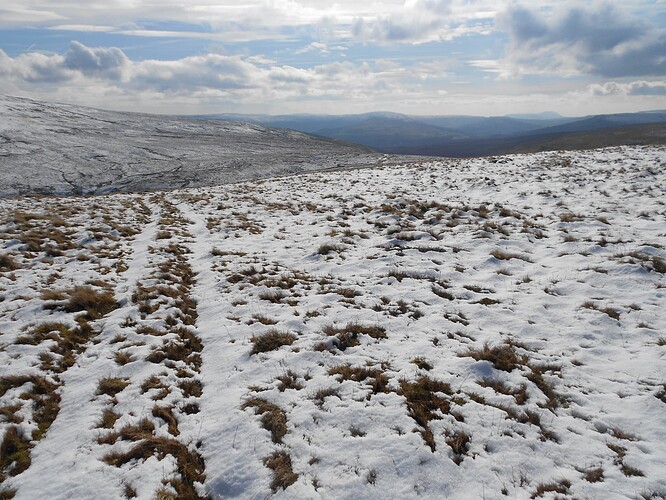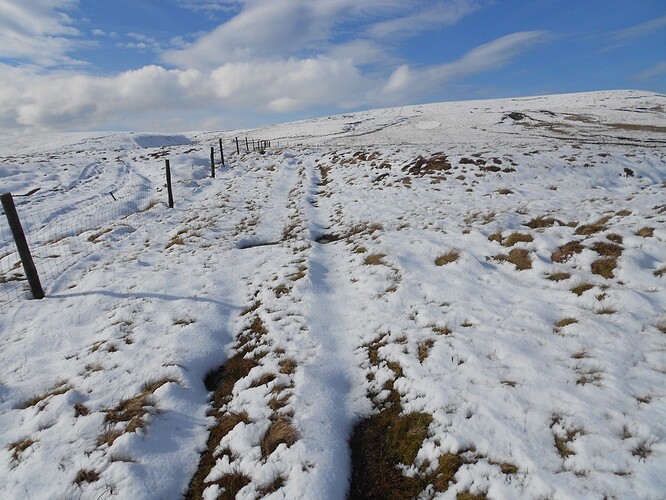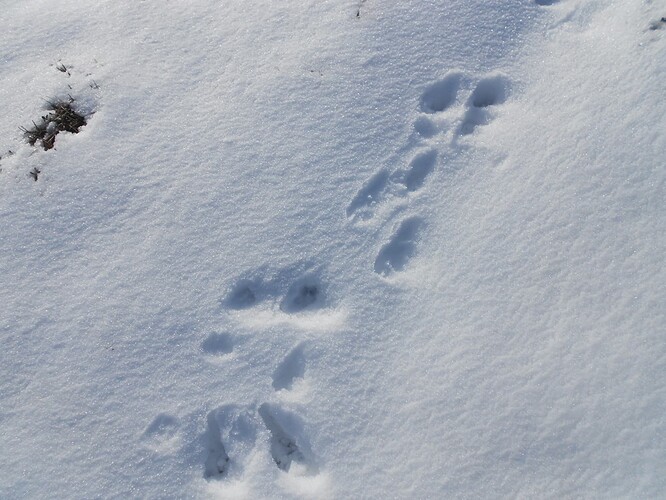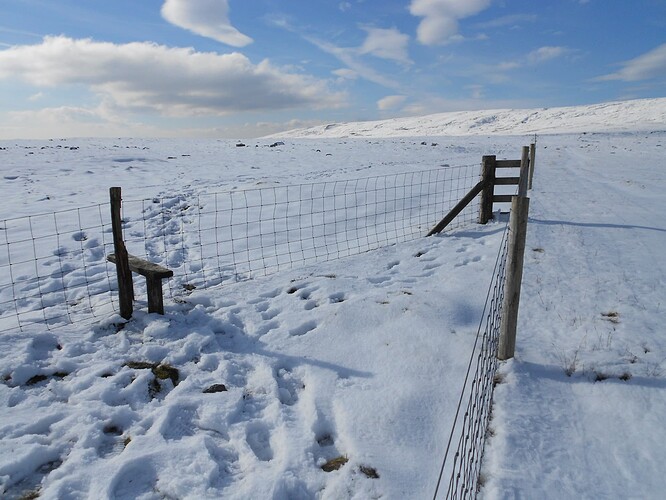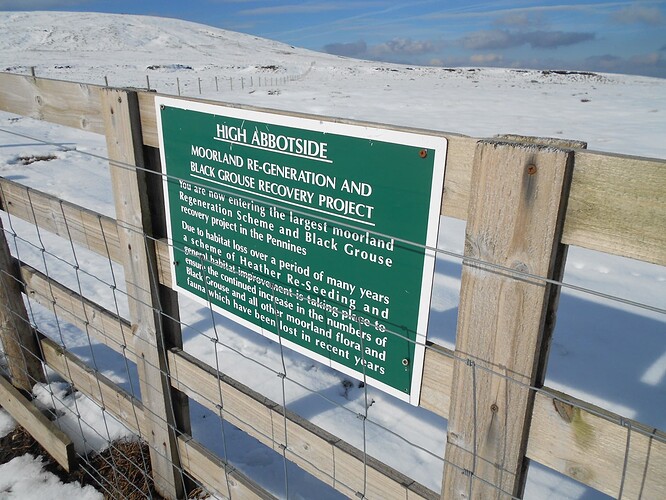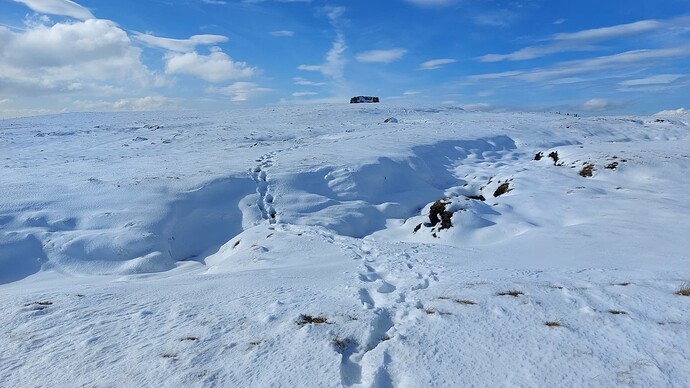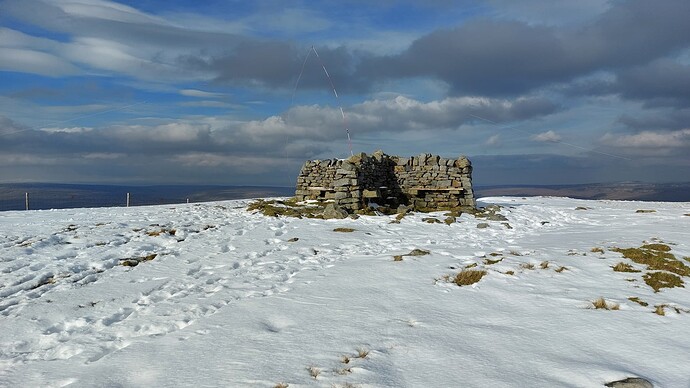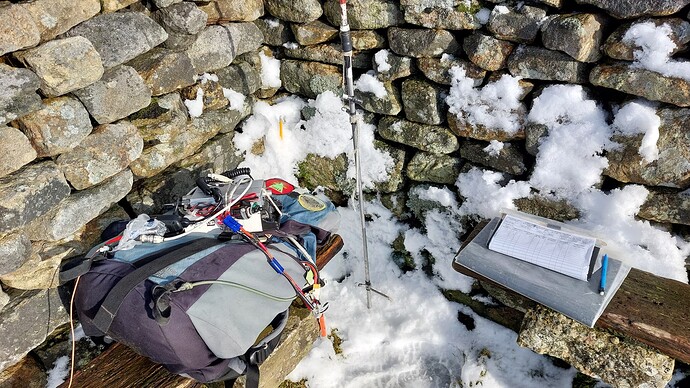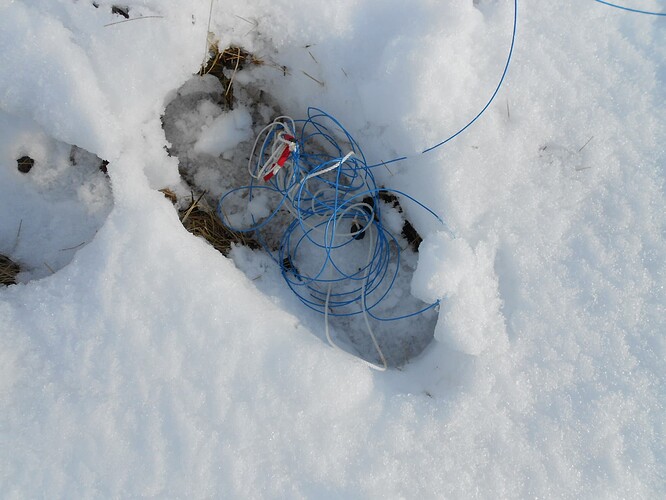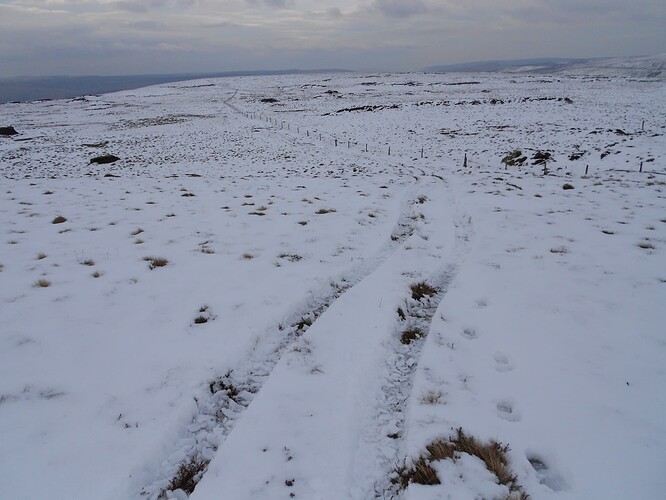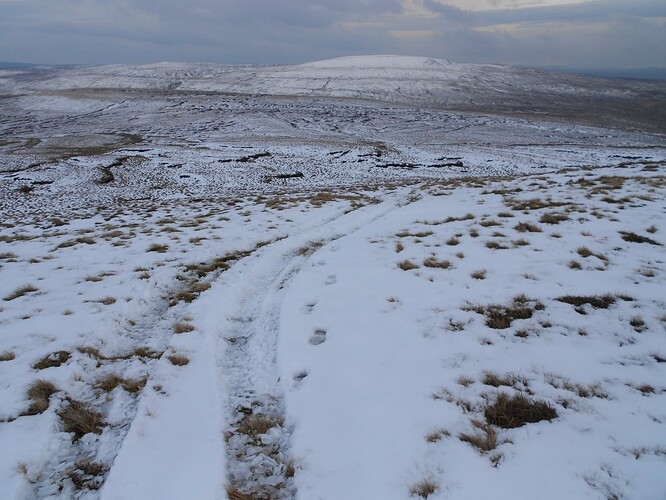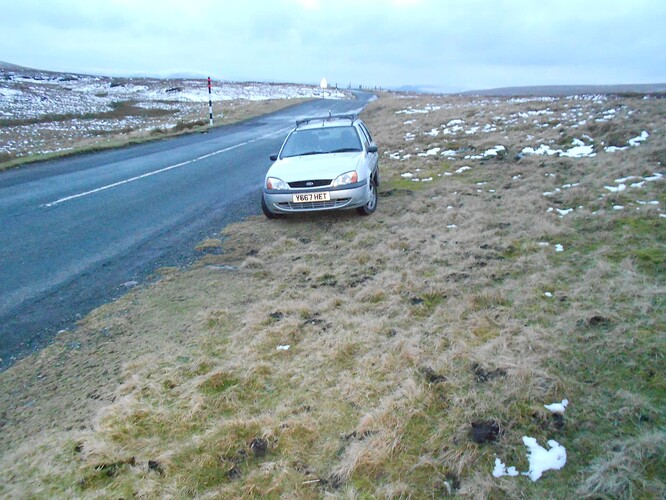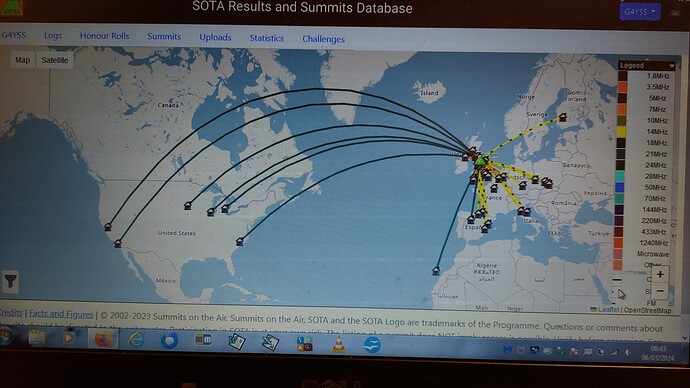G4YSS Activation Report for NP15, NP6 on 04-03-24
Issue-2 (typos). Pse Rprt Errors
G/NP-015 /4 GREAT KNOUTBERRY HILL
G/NP-006 /6 GREAT SHUNNER FELL
NP15: 2m-FM QRP
NP6: 40m-20m-15m CW/ SSB QRO & 2m-FM QRP
G4YSS - Unaccompanied
All times UTC
EQUIPMENT:
VHF NP15:
Moonraker MT270M V-UHF 25W Mobile with Pye filter (rig failed to transmit)
Vertex VX-150, 5W VHF H/H (used for NP15)
Reserve: UV-3R 2 Band, 2W V-UHF H/H (not req’d)
HF/ VHF NP6:
FT817ND HF/VHF/UHF 5W Transceiver
MX-P50M HF (80 thru’ 10) 50 Watt linear amplifier with 160m capability
Adjustable link dipole for 80-40-20-15-10 (Raychem-55)
5m home-brew CFC mast with 1m end sticks
Batteries:
NP15: VX-150 attached 2.2Ah Li-Ion battery
NP6: One HRB, 5 Ah Li-Po battery
Other:
Garmin Geko 301 GPS
MP3 Player & DAB Radio
Pack weights:
NP15: 10kg (22 pounds) inc. 250ml water
NP6: 10.8kg (24 pounds) inc. 250ml water
INTRODUCTION:
Late opening for business in 2024, following vague thoughts that I should do ‘something’ this was planned as little as possible or more accurately not at all. In my Excel log, winter activations are highlighted in blue but I’m ashamed to say that there hasn’t been too much of that colour in recent years. My excuse for the umpteenth time - the driving distances.
The CO Alarm:
For this activation we have to thank a CO alarm which woke me at 5am. This good servant is a hard master when it decides in the middle of the night that its AA batteries have got down to 1.1 Volts. Beeping every two minutes, I’d give it ten out of ten for persistence and eleven for annoyance so by 05:30 I’d had about as much of this ‘saw-tooth existence’ as I could stand. It was not merely telling me to get out of bed and feed it, this was surely a brutal hint for a SOTA expedition.
The problem with impromptu processes is the associated lack of preparation. No sandwiches made, batteries not charged, no GPS routes loaded, neither Sotawatch nor even the XYL alerted and the car fuel tank almost empty etc etc. All had to be done in a rush with no time for breakfast but by just gone seven I was as ready as I was ever going to be.
I gathered from members at SARS that there was DX to be had on the higher bands these days so my idea just for a change, was to try to bag some. My regular link dipole only goes up as far as 20m so I dug out one that I use abroad which allows the use of 15m and 10m. This would be from one summit only and since I was more likely to get over the ‘pond’ in the afternoon, HF would feature from the second one. Whether that would be NP15 or NP6 had to be decided on the way.
EXECUTION:
After leaving a note for my XYL, I left Scarborough at 07:10, driving via East Ayton petrol station. As is often the case, there was fog on top of Sutton Bank which extended further west, so progress along the A170, A168, A1M and A684 roads, was slow. Eventually the Coal Road parking place was reached (09:45/ 95 miles) but with no internet alerts I was spared the stressful clock-watching.
Ice Sheet:
The 1,700 foot ASL Coal Road, which has a year-round notice about Winter Conditions, was not without its excitement. On the first hill a 30 metre long ice sheet was in evidence. The road is both narrow and steep so I became somewhat concerned about my chances of clearing the hazard without ending in the ditch. This could only be done with inertia as once on the ice, there was little or no grip. With front wheels spinning and the speed rapidly dropping off I barely managed to reach dry tarmac. Without this good fortune NP15 would have been off.
NP15 ROUTE:
Leaving the Coal Road at SD 7796 8805 you walk via the track, turning left at the gate and sheep pens at SD 7768 8744 and thereafter, up beside the fence. It’s indirect and boggy in places but better than the bee-line I used to take. The ascent was started at 10:11.
G/NP-015: GREAT KNOUTBERRY HILL, 672m, 4 pts. 10:46 to 11:52. 0 Deg. C 20 mph SE wind. Sunny. Approx 3 inches of lying snow and deeper in drifts. IO84KP; WAB SD78. Trig Point TP3461. (Vodafone signal).
I set up the J-Pole in the rocks at top of the shelter seat and connected it the MT270M mobile rig. As had happened Boxing Day on Skiddaw it either shut down or the display ‘scrambled’ just after the PTT was pressed. I put this down to the cold and damp as home tests after Skiddaw failed to reveal any fault. This would be the case again the day after this latest episode but this time I put the rig in the fridge for two hours. Still no fault! The long-time reliable VX-150 was deployed, this time with success.
145.550 FM - 7 QSO’s:
After a self spot I worked the following stations with 5W to the vertical:
G7WAW David in Barnoldswick, who told me that long ago I was his first SOTA chase; G8WT Tony at Whalley near Clitheroe and M6MOS Malcolm just north of Carlisle.
G0MHF John at Birkenhead was using an FT818 with 5W to the apparently popular Diamond X50 collinear; next GM3VMB, old acquaintance Peter in Eaglesfield; G0PMJ Dave – Darlington and finally G6AEK/M Dave who described his current location as ‘800 feet ASL on the southerly aspect of Winter Hill.’ I was to meet Dave again on 40m later in the day. Signals on my meter ranged from 57 to 59. Incoming reports were all Q5 with the exception of a 41 from Birkenhead.
Though cold and windy, it was a beautiful day and there were five passers-by including a chap with a very large hairy dog. After the usual panorama photos I packed up, roughly throwing the delinquent mobile rig into the rucksack in disgust. No matter; NP15 was more than qualified. Sunshine, stunning views and great fellowship had done wonders for my mood.
NP15 Descent:
Setting off for the car, I tried a minor detour to investigate a vertical white stick 100m east of the trig (no, not the kind of white stick). However, after the snow became deeper than my boot tops I withdrew. I didn’t want wet feet at this stage though that would come later. The path down is boggy with at least one hole in the ground hidden by snow. As luck would have it and because of the snow, the landing was soft with only pride taking a hit. Yes, there was some swearing but thankfully no witnesses. The parking place, where there was now a Yorkshire Dales Warden’s vehicle with the occupant having his lunch, was reached by 12:19.
Drive to NP6:
There is the option to drive through Hawes but I chose to bypass it via the Green Dragon Pub at Hardraw. The 12 mile drive with a short stop to text the family, took half an hour to 12:56. There’s just enough space to park on the verge where the grassy track leaves the road (SD 8688 9570). The weather was good; sunny but with a cold wind. There were only a few small patches of lying snow at that level but it would gradually increase with height.
NP6 ROUTE:
From SD 8688 9570 on Buttertubs Pass the track goes up via Coal Pit to the fence corner at SD 8694 9639 (turn left). The fence bends again at SD 8680 9653 at Grimy Gutter Hags. There’s another direction change - left (WSW) at SD 8586 9707. The track passes the end of a wall at SD 8542 9687 and after some steep sections you eventually reach a stile (optional) at SD 8503 9723, not far short of the summit. There’s not too much ascent (about 200m) but it’s a longish slog (2.2 miles) over wet ground with a few steep sections.
After repacking the rucksack for HF-QRO, I got walking by 13:10. A grassy track with snow patches that were beginning to soften in the sunshine. In case the shelter was occupied, I strapped the tent flysheet to the pack then took it off again due to weight and the extra time needed to set up and take down. That turned out to be a good decision; in fact I saw no walkers for the remainder of the day which made the stone shelter available.
The snow soon reached the point where it was noticeably impeding progress, especially with the heavier load and for picking the way through Grimy Gutter Haggs. I’d had to break trail as far as the wall end but there I saw a few footprints over a stile at the southerly side of the fence. Following them didn’t provide much advantage however, especially higher up where the going became rougher with fissures cutting the ground. Yes, this ‘new’ way takes a more direct line to the summit shelter from around 800m out but I won’t be using it again. The ascent took ten minutes longer than usual and was extra tiring in large part due to snow which was well over boot tops in places. The ascent took 64 minutes.
Setting up on NP6:
The HF link dipole was set up in the shelter with the mast through snow and into the ground which unexpectedly was not frozen. In case any ‘normal’ people should visit, I took second choice of where to sit, leaving the fully sheltered quadrant vacant. In doing so and knowing I would be there for some hours, I would have to accept only partial shelter from the strong wind and wind-chill but in the event nobody came. To enable better dexterity, no gloves were worn for the duration. As I’ve said many times in the past the choices for winter SOTA in the UK are numb gloves or numb fingers.
The dipole didn’t go up particularly well. That was not only due to a smallish included angle required with an unguyed mast in a strong wind but also because it tangled up while my back was turned. The latter took a while to sort out but one of the outer sections was beyond redemption in the circumstances, meaning I would have to make do with 7 MHz and above. Because the strong wind was making things worse, I kicked a hole in the snow big enough to take the resultant ‘rats nest.’ With snow over grass the end sticks were no problem. Just as well, it was very cold to windward.
G/NP-006: GT. SHUNNER FELL, 716m, 6 pts. 14:14 to 17:04, 3C. Wind: SE at 30 mph. Sunshine until later. Lying snow 3 inches with up to of 8 inches in drifts and gullies. IO84VI, WAB SD89. Trig Pt: TP-3468 integral with shelter. Vodafone signal 4G.
First thoughts were to set up 2m-FM, make it quick and beat it back to the car. I’m glad I didn’t but as it turned out there was quite a lot of work for me on Great Shunner Fell. Here’s the rundown:
14.061 CW - 9 QSO’s:
F6ABG Norbert; F5PLR ‘Did’; G4OBK Phil - Pickering; DL3NM Hannes; SO6K Dariusz (Poland); I5QNJ ??; G4TGJ Richard in Ilkley; OH50LOW Tom and the easily identified callsign, SP9AMH Mariusz who was probably running QRP?
I was surprised but pleased to log Phil and Richard; the two UK stations of this session, though both were at least vaguely approaching line-of-sight. Nevertheless there was quite deep QSB on Phil’s signal if not Richard’s too.
Outgoing reports during the 15 minute operation were between 57 and 59 and in response to my 50W signal I got 449 to 579 with QSB coming back. My CW was rusty. No, not just rusty but terrible with extra dots and dashes flying all over the place courtesy of me and my miniature centre-off toggle switch. There were far too many corrections required. Then when you add the excitement or, more like it, trepidation of being back in the ‘lion’s den’ after so long an absence, there was no wonder sending was shaky. No matter, I’m certain that these experienced chasers knew what was meant and seemed only too happy to get the points on offer however they came. Besides I did improve a little as I went on. Thanks chasers.
14.280 SSB - 11 QSO’s:
In the 20m SSB log:
EA5GV Jose; OK1SDE Borek; IK6BAK Eliseo; DB5TR/P Tom S2S on DM/BM-154 and IN3EHQ/P Manuel S2S on I/VE-266. The latter two ops shouted ‘S2S’ and were worked as priority. Tom was 57 and Manuel 55.
Continuing on: 3Z9VI Tom; OH3GZ the familiar callsign of Jukka; EA3EVL Pablo; EA2CKX Pedro (another one from the past); SP6KEP a club station and finally EA1GKP Justo in Valladolid. Power remained at 50W with outgoing and incoming reports all between 55 and 59 and the session took 13 minutes. It was now time to adjust the links.
21.061 CW - 5 QSO’s:
Now for an adventure! It was up to the never before dizzy heights of 15m, or at least I can’t remember ever going that high for SOTA from the UK. This is where DX’ers cluster so CW would be even faster. However, my rig is set to 19 WPM and mostly the chasers respected that.
Stations worked: K8LJG John in Flint MI; ND0C Randy in Worthington MN using just 5W; EC8ADS Alfredo Gran Canaria; KF9D Roger - Algonquin IL and W6LEN Jess in Huntington Beach, CA.
Completed in 9 minutes, this session was certainly notable but there was more to come in SSB. Outgoing reports were 579 to 599 with a 559 for Jess. Coming back the range was 539 to 579. Power was set at 50W again and for the HF sessions following.
21.246 SSB - 4 QSO’s:
I wasn’t banking on SSB delivering the way CW had but I was pleasantly surprised:
AE4FZ Charles – Fayetteville NC; EA1GKP Justo in Valladolid; EA8DDN somewhere in the Canary Isles and K6YK John in Stockton CA. Reports sent were 57 to 59 with one 55 for Charles. Coming back 55; 33; 59 and 52 respectively and all with QSB. The quality was there but I’d expected a few more customers. Nonetheless the freq dried up after 5 minutes.
7.131 SSB - 21 QSO’s:
The 10m band, checked earlier, didn’t seem to be up to much, so now to matters more local: M0VAZ John - Wirral; M0MDA Mick in Leeds; G0RQL Don in Devon; MM0XPZ Steve - Greenock; G4WHA/M Geoff outside his wokplace in Carlisle; G7SXR Mark - Drighlington (Leeds); G6LKB Dave in Ulverston, who collected the ‘full package’ of SOTA ref, WAB Square and trig point.
Moving on: ON3DWG Guy - Horebeke; G0FVH David in Poole Dorset; G6TSJ Phill in Buckingham; GI0AZA Esther - Dungiven, Londonderry; 2E0FEH Karl - Saltash using 90W; G8VNW Nick in Threshfield - a 160m regular; ON3RMB Kris; G0HRT Rob who has now moved south and M0ICR Carl in NW London.
Next a curious one: M1AOB/M Richard called in with ‘Park to Park’ followed by the ref FF-0413? I think he mentioned that Karl would relay the ref if I didn’t hear it. I had no appropriate ref to send back so I stuck with the SOTA one.
Late on parade was Esther’s other half GI0AZB, Ian in Dungiven. I already knew he’d been out cutting the hedges so I enquired if he still had all his fingers which elicited a laugh.
Finally I worked GM0NCA Robert; G6AEK Dave in Poulton-le-Fylde, who I’d worked on VHF from NP15 in the morning and M7WUK Scott in Telford. Mark G7SXR was keen to bag NP6 on 2m-FM so off I went to try and oblige. The 21 stations were worked in half an hour.
145.400 FM - 4 QSO’s:
Using 5W to the J-Pole, G7SXR Mark in Drighlington came back to my first CQ on S20 so mission accomplished. He was followed by M7CQS Steve in Chatburn near Clitheroe; GM6TVR John – Annan and and the final QSO of the day, G6CRV Dave in Heysham.
Five of the eight reports were 59 with 52, 55 and 56 incoming from Mark, Steve and Dave respectively. The 2m-FM session spanned 11 minutes but time was getting critical. It would be dark soon enough. Water droplets, propelled by the strong wind from thawing snow on the shelter wall-top, had made everything cold and damp. Wet feet caused by boots overwhelmed in deep snow and a rand who’s bond to the uppers is breaking down, added to the general discomfort. Moreover, despite being provided with a decent place to sit, I was quite stiff and shivery with cold. The absorbing radio work had taken my mind off the hardships but now was the time to brave that mean wind and get going again.
Final descent:
With HF and VHF aerials to take down, packing up would have taken twenty minutes but before going on VHF I cleared the HF the kit for no other reason than to warm up a little. The tangled dipole had to be roughly reeled-in coax first for attention the following day. A quad track, which had appeared since the ascent and which went well up towards the top, helped with underfoot conditions on the way down. The BBC World Service on DAB, a solid signal apart from when I dropped down to cross the Grimy gutter, was a welcome distraction. After walking into the cold wind for close to an hour, the car was a welcome sight as dusk fell at 17:57. Impeded by the snow, the walk down had taken 53 minutes.
Radio Caroline’s 4 kW signal on 648 kHz MW was booming in from Orford Ness after I reached the car but quickly faded into the noise at the start of the drive back. Sorry to mention that but I do so love MW and always have since listening on my Mum’s Bush DAC 90A brown Bakelite valve radio in the 1950’s and 60’s.
The 83 mile drive home (18:03 to 20:30) was via the A684, Thirsk and Sutton Bank but I was forced to stop in Helmsley due to leg cramp. A dose of ENO’s cleared that up in less than a minute.
61 QSO’S for the day comprising:
NP15: 6 on 2m-FM
NP6
9 on 20m CW
11 on 20m SSB
5 on 15m CW
4 on 15m SSB
21 on 40m SSB
4 on 2m-FM
Total NP6: 54
BATTERY UTILISATION:
NP15: Handheld integral battery only, part used
NP6: One HRB 5 Ah Li-Po battery (85% discharged)
Round Trip Ascent & Distance (on lying snow):
NP15: 176m (577ft) ascent, 3.9 km (2.4 miles). Times: 35U, 27D
NP6: 200m (656ft) ascent, 7.1 km (4.4 mls). Times: 64U, 53D
TOTAL: 376m (1,234ft) Ascent -11 km (6.9 miles) Walked
Times: 1hr-39 min of ascent; 1hr-20 min of descent
Total walking time: 3hr-59 min
Summit times: NP15: 1h-6m. NP6: 2h-50m
Tot: 3hr-56m
Chronology:
Scarborough: 07:10
Arr.Coal Rd (95 miles): 09:45
Walk for NP15: 10:11
NP15: 10:46 to 11:52
Rtn. Coal Road: 12:19
Drive to Buttertubs (12 miles): 12:27 to 12:56
Walk for NP6: 13:10
NP6: 14:14 to 17:04
Rtn. Buttertubs: 17:57
Drive Home: 18:03 to 20:30 (A684-Thirsk-A170, 83 miles)
Distance driven: 190 miles (95+12+83)
Activator points: 16 (inc 6 WB)
OBSERVATIONS:
I used to put on at least three NP summits in the day, sometimes four and once six but nowadays we’re down to two! In a way I did ‘train’ for this by walking generally 5 miles every day and two or three times a week up from my house to HEMA Seamer Beacon HTW-008. Best time is 32 minutes and I sometimes activate it with 5W to a vertical, often working Mark G7SXR in Leeds and one or two others.
I stopped to speak to several people on NP15 but despite the footprints, no walkers were seen on NP6. Neither did I see or hear the farmer’s quad bike. There wasn’t much wild life in evidence either, apart from the odd Red Grouse and what I though may have been a Curlew.
Conditions were good on all HF bands worked. There was significant QSB but it wasn’t a show stopper. No doubt 50 Watts helps with that, so the amp is worth carrying. 40m was very noisy and it was tricky to find a space on there. Fortunately 40m propagation favoured both the EU and UK stations together. If there’d been no UK prop I could not have QSY’d to 80m due to the tangled dipole outer section. It took some sorting at home the day after never mind on a cold, snowy, windswept summit and by necessity without gloves.
Son G0UUU, who picked up my signal from home via the Nantwich web receiver, rushed out in his car in the hope of working me from the nearby quiet location of Throxenby Mere, Scarborough. Unfortunately by the time he got there and screwed the 40m whip on the mag mount, I’d gone QRT! Sorry Phil.
What I’d hoped for was achieved. The QSO map proves that DX was worked and I had a chat with John K6YK who told me that he can’t work European SOTA’s on bands below 21 Mhz. In the past I have worked a few North American stations on 14 MHz but I’m thinking that I should add a link for 18 MHz or 21 MHz to my regular dipole. The problem is that when the sunspots are gone I’ll be left with the addition of a further potential tangling and spooling issue. Maybe I’ll try the 40m config. as it might work on 15.
I had two equipment problems. After one failure on Skiddaw at Christmas, the Moonraker MT270M VHF mobile rig failed to transmit for a second time on NP15 and the dipole tangled up on NP6. The rig tested-out at home OK and passed a further test after two hours in the fridge so I’m both flummoxed and fast loosing confidence. Not only that but my 1999 IC706-2G, used for 160m on countless SOTA’s in the past, seems to be having transmit issues too.
As for the dipole I can understand the problem. The 22 AWG Raychem 55 airframe wire from which it is made, is designed for up to 150 degrees C working. In cold conditions it suffers from a significant memory effect with the result that it curled up like a spring. I should have been more careful about what I retrieved from the skip at work all those years ago but who am I to look a gift horse in the mouth? Of course I never noticed this before as that particular dipole has only been used in hot locations such as CT3, EA6 and EA8 etc. My regular dipole uses 24 AWG PTFE insulated wire and it doesn’t tangle often.
Phone:
As before, Vodafone coverage was good today on both summits with 4G most of the time on NP6.
THANKS:
Thanks to ALL STATIONS WORKED and the excellent Sotawatch spotting service without which things could easily be somewhat grim.
73, John G4YSS.
…
Photos: 4-6-7-10-13-31-P2-34-44-50-51-53-61-65-66-P1-P3-P4-92-97-98-100-QSO Map
Above: The start point for Great Knoutberry on the Coal Road. My 2001 Ford Fiesta. The sign reads: Arten Gill Moss 2 milesAbove: Along the track to the sheep pens. Ingleborough NP5 (left) and Whernside NP4 (right) in the distance.
Above: The way up NP15 from the track and sheep pens
Above: The approach to the summit
Above: Summit of G/NP-015 Great Knoutberry
Above: Not a good start. The Moonraker MT270M VHF mobile would not transmit
Above: G/NP-015 activation. Ingleborough G/NP-005 (left) and Whernside G/NP-004 (right) in the distance.
Above: The reliable and solidly built Vertex (Yaesu) VX150 2m-FM mono-bander which was recently treated to a 2.2 Ah Li-Ion battery.
Above: On my way down NP15. A couple who had walked all the way up from Dent Station.
Above: Parking in Buttertubs Pass at 1pm in readiness for Great Shunner Fell NP6
Above: Looking back over Buttertubs Pass with the slopes of Lovely Seat (ex G/NP-030) to the left
Above: Breaking trail to NP6 on the track by the fence
Above: Animal prints but what animal?
Above: Human footprints over the stile. I was fooled!
Above: Black Grouse reintroduction scheme. I can’t ever remember seeing a Black Grouse in England so good luck to them. There are plenty in GM.
Above: Summit in sight but snow getting deeper
Above: Activation of Great Shunner G/NP-006 on HF. It looks serene but there was significant wind-chill
Above: G/NP-006 and HF kit.
Above: The taffled-up dipole. No 80m today
Above: On the way down and helped by the latest addition. The Quad tyre tracks that appeared since the ascent.
Above: Making progress back to the car. Lovely Seat again in the distance.
Above: A welcome sight - my trusty old banger
Above: My boasting map!
